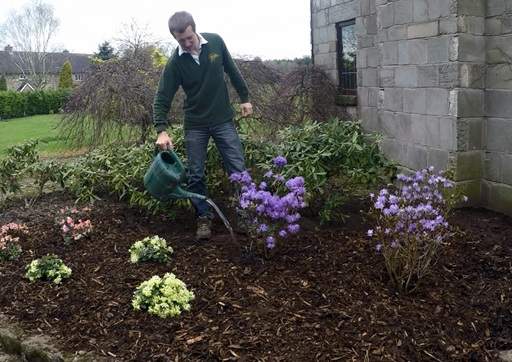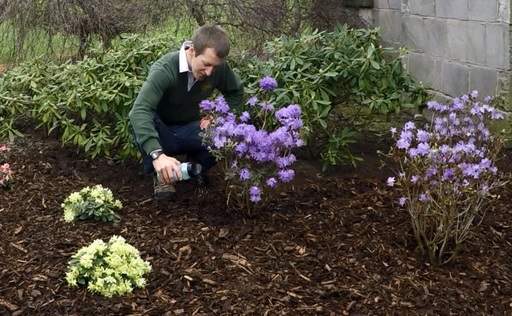Check Here Before Buying – Pot Size Matters...Not all websites offer the same. Plants in a 2-litre pot have twice the root system of a P9 or 1 litre pot.
How to plant, grow and care for Rhododendrons
Rhododendrons are best known for their spectacular clusters of large, showy and often fragrant flowers. These are typically tubular, funnel, or bell-shaped and available in a range of colours spanning reds, yellows, pinks, purples and even white. Most rhodos flower in spring but there is also a growing range of summer flowering varieties perfect for adding charm and beauty to your garden, whilst deciduous azaleas also offer beautiful autumn foliage colour. Originating from the Himalayas, Rhododendrons have long been a mainstay of the woodland garden since being introduced into Britain by Victorian plant hunters. They are acid-loving shrubs, generally growing well in partial or dappled shade and combining well with the likes of Pieris 'Forest Flame' and Euphorbia 'Tasmanian Tiger'. There are a huge range of rhododendrons with over 900 varieties spanning low growing ground cover plants to specimens that can reach 6 metres tall. Larger varieties make great hedges, screens and foundation plants whilst dwarf alpines are highly effective in rock gardens and compact hybrids look excellent in containers positioned in a shaded spot of the garden.

Pink rhododendron flowers with orange throats
Rhododendron Planting Guide
Finding the right location
- Rhododendrons are a bit fussy, so it's worth spending some time to make sure you get the planting location right at the outset.
- Large-leaved varieties must have partial shade (a sunny spot that receives a couple of hours of shade in the morning and early afternoon is ideal) or dappled shade. On the fringe of an open tree canopy is good but avoid positioning rhododendrons in deep shade directly below a densely branching tree. Some shade in the height of the afternoon is particularly important for locations in the south of the UK that are a little hotter.
- Azaleas are much more tolerant of full sun and in fact dwarf alpine varieties actively prefer it. However, it is still important to prevent the soil surrounding azaleas from drying out.
- An acidic soil is essential, ideally humus-rich, moist yet free draining. If you have an alkaline soil, we recommend growing rhodos in a container, rather than trying to alter the acidity of your soil, which is not straightforward as the change is only temporary.

If growing rhododendrons in containers, use an ericaceous compost
- Rhododendrons don't like having wet feet; in fact, soggy, waterlogged ground is the most common cause of failure. If you have a heavy clay soil, plant your rhododendron in a mound of improved soil as described below. On the flip-side, rhododendrons do like lots of moisture so avoid planting under the eves of building were rainwater won't find it's way to their roots. Azaleas are a bit more forgiving of soil conditions but again acidity is key.
- Avoid planting too close to large trees, hedges and shrubs which will steal moisture and nutrients from the surrounding soil, as well as walls and fences. Look at the eventual spread of your preferred variety to determine how much space to leave between your plants and surrounding objects in your garden.
- Choose a location protected from strong, cold or drying winds and frost pockets. If your garden is particularly exposed, plant on the north side of a building or leeward side of a windbreak as flower buds are liable to dry out and die if they're left exposed. Rhododendrons will tolerate a more open site in less windy locations.

Rhododendron flower buds starting to open in the spring
Garden Design & Spacing
- Rhododendrons look best when grown in groupings to create block colours. Grow groups of 3-5 of the same variety in loose drifts and choose an overarching scheme of around 3 colours if you have a larger area to plant up.
- Check the eventual height and spread of your preferred varieties to determine how far apart to plant them. In theory plants should be positioned the same distance apart as their eventual spread, although it's possible to reduce this by up to 20% if you want more of an instant effect and/or want your plants to merge into blocks of foliage and flower colours over time. For example, for rhododendrons with an eventual spread of 2.5 metres, you could get away with planting 2 metres apart.
When to plant
- Containerised rhododendrons can be planted at any time of the year but if you're able to choose, either October or between March and April is best.
- Autumn planting has the benefit of giving them time to settle in and grow new roots before winter, so they are well-established by spring and can really start putting on some growth.
- On the other hand, by waiting until March-April you'll have the advantage of being able to see the colour and size of the flowers when you buy them (if you choose to visit our garden centre in Staffordshire to buy them of course).
- Plant at a time when the ground is not frozen or waterlogged and ideally when it's not excessively windy. If planting in the spring it's best to wait until all risk of frost has passed.

Avoid planting rhododendrons when the ground is frozen or waterlogged
Soil preparation
- Before planting your rhododendron, start by clearing any perennial weeds and grass from your planting site.
- Dig in plenty of ericaceous (lime free) compost or acidic organic mater into the soil. Good choices of materials are decomposing pine needles, composted tree bark, leafmould, chopped, composted bracken or peat substitute. Composted Christmas tree branches are also ideal. Do not use animal manure which is too strong for sensitive rhododendron roots or mushroom compost which is too limey.
- Rhododendrons are shallow and reasonably wide rooting so it's important to mix this well into the soil both at and around the planting site. You'll need to build in at least 10 litres of compost for dwarf rhododendrons and 20 litres for larger hybrids, even on good soils. For specimens work on the basis of 60 litres per plant.
- If you have an alkaline soil, one option is to increase the acidity of the soil using wettable sulfur or ferrous sulphate. Avoid using aluminium sulphate as it is toxic to rhododendron and azalea roots. At Jackson's Nurseries we actually advise against trying to make alkaline soils more acidic because it's not straightforward and any change will only last for a limited period with the natural alkalinity returning over time. Instead, grow a compact hybrid in container or install a raised bed, using a humus-rich ericaceous compost in both cases.
- If you're planting a full border, cultivate the whole area, rather than digging individual holes.

Pine needles are ideal for incorporating into the growing mix
How to plant a rhododendron

- Dig your planting hole as deep as the root ball and twice as wide. You will be aiming to plant at the same level as your rhododendron was in the pot with the roots just very slightly below the soil.
- Next, take the root ball out of its container and gently tease out any roots that may have started to circle around the base of the pot by pushing your fingers into the bottom edge of the rootball and pulling outwards. Doing this a few times will loosen the roots and encourage them to spread into the surrounding soil once planted. If roots are difficult to loosen by hand, make four shallow cuts into the root mass near the bottom with a sharp knife. This will promote growth into the surrounding soil.
- Give your plant a brief soaking in a tub or bucket of water until the air bubbles disappear. Gently shake the root ball to allow excess water to drain off before positioning it in your planting hole.
- Planting too deeply, particularly in wet soils, will cause the roots to rot and invariably lead to failure. A good trick is to use a cane laid across your planting hole before backfilling to check the exact planting depth. If your plant sits too low, take it back out of the hole and add some soil back into the base. If it sits too high, dig your planting hole a little deeper. Again, the number one reason for rhododendrons failing is due to wet feet and this is most commonly caused by planting too deep so that lower stems are buried below soil level.

Use a cane laid across your planting hole to check the planting depth
- Next, start backfilling the dug soil, securing the soil around the roots with your hand as you go along. Once half filled, water well to settle the soil before continuing with the rest of the soil.
- Mulch with acidic material such as pine needles, bark or conifer clippings once complete, leaving a 2 inch (5cm) gap between the mulch and the base of your plants to reduce the risk of disease. Do not stand on or compress mulch - it should be kept well-aerated rather than packed down.
Planting Rhododendrons in a mound of improved soil in very heavy clay conditions
- If you have a heavy clay soil, plant your rhododendron in a mound of improved soil above the base clay soil. This is required because if you dig a hole in very heavy soil and fill it back with a light soil mixture, you'll effectively just end up creating a bucket in the ground made of slick clay, which will hold too much water.

Rhododendron Garden Care
Weeding
- Keep your rhododendrons clear of perennial weeds during the growing season. Weeds are best removed by hand rather than using a hoe which could damage the shallow roots of your plants.
Watering
- Rhododendrons are native to areas with high rainfall, so they are naturally suited to moist soils. They are also shallow rooting so won't compete with nearby deeper rooted plants for moisture. Watering will be required during prolonged periods of hot, dry weather in late spring, summer and early autumn.
- A rough guide is to water your plants if there has been less than 1 inch (2.5cm) of rain per week. Shade-loving annuals such as impatiens can be planted around or in front of your rhododendrons as companion plants to help indicate when water is needed.
- Rhododendrons do not like the calcium from tap water in hard water areas as this neutralises the acidity of the soil. If you live in a hard water region, water your rhododendron plants with collected rainwater where possible.

Mulching
- Rhododendrons benefit from a generous mulch of pine needles or bark each spring. This has four key benefits:
1) Helps to retain moisture by preventing evaporation from the surface of the soil
2) Suppresses weeds around your plants which would compete for water and nutrients
3) Acts as insulation to protect the roots from harsh frosts in the winter
4) Provides a gradual stream of nutrients to your plants as it decomposes
- Leave a 2 inch (5cm) gab between the mulch and the base of your plants to reduce the risk of disease.
- Do not use weed suppressing matting or gravel which prevents air from reaching the roots and impairs drainage.
Feeding
- Rhododendrons and azaleas should be fertilised sparingly because excessive applications can burn the roots.
- Sprinkle some slow-release ericaceous plant food around the base of your plants in early spring, just as the flower buds are starting to swell. As always, follow the instructions on the package but 70 grams (half a handful) per square metre is about right.
- Avoid feeding rhododendrons with bone meal as it contains too much calcium.

Feed rhododendrons with slow release ericaceous plant food
Pruning
- Rhododendrons do not require any pruning other than to remove any dead, damaged and crossing branches.
- The only other reason you might need to prune is to reduce the height and spread of your plants to within required bounds. It is much better if you can check the space you have available and choose a variety with an appropriate eventual height and spread at the outset because if you do need to prune an established bush heavily, it may not bloom again for two to three years.
- If you need to reduce the size of your plants, prune after flowering has finished in the spring. Do this by making clean cuts using a sharp pair of secateurs. Feed with a slow release ericaceous plant food after cutting your plants back, if you haven't already.
Deadheading
- Deadhead spent flowers once they have faded to help encourage a second flush of blooms. Deadheading also keeps your plants looking tidy and will prevent seed production once flowering is over, so your plants focus their energy on developing fresh leafy foliage instead.
- Remove flowers carefully as next year's flowering buds are immediately below the current season's flowers and if you cut them off by accident you'll have no display the following year. Do this by snapping off spent flower stalks by bending them over until they break away.

Deadhead rhododendrons with loppers or secateurs
Cold Protection
- Rhododendrons are frost hardy in most of the UK with evergreens normally only requiring protection during severe winters. This can be achieved by wrapping a few layers of horticultural fleece around your plants.
Problems, Pests and Diseases
Moisture Issues
- Leaf drop - leaves falling to the ground following a period of dry weather. Usually proceeded by the leaves starting to droop down and roll up.
- Bud blast - if your rhododendrons fail to flower successfully, the most likely cause is a lack of moisture the previous summer when the buds were starting to form. Dry conditions at this time will cause buds to fail or partially form then drop off.
- Recommended Solution: Mulch to help retain moisture and water regularly during prolonged periods of hot, dry weather.
Insect Issues
- Vine weevil - insects that can infest your plans and destroy the leaves. They develop from grubs which eat the roots.
- Caterpillars - can infest rhododendrons and will munch through particularly large leaved varieties quite quickly.
- Leafhoppers - another form of insect that suck sap out of your plants, causing a pale mottling on the foliage.
- Scale insects - suck sap from your plants and excrete a sticky honeydew substance which often leads to the growth of black, sooty moulds.
- Recommended Solution: Treat with a bug killer spray.
Fungus Issues
- Powdery mildew - a fungal disease causing a white or yellowish dusty coating over foliage, flowers and stems.
- Rust - one of the most common of garden diseases characterised by orange, yellow or brownish spots on leaves. Usually seen from mid- to late-summer and autumn.
- Petal blight - another form of fungal disease that develops in flowers and is brought on by moist, damp conditions. Identified by brown flecks on petals that rapidly merge to form blotches and, if left untreated, will continue to engulf your flowers until they die and fall to the ground.
- Recommended Solution: Treat the affected areas with a fungus killer. If your plants have suffered from petal blight in a previous season, we recommend using a fungus killer as a preventative measure once a week from when the flowers open. Otherwise, by the time you've actually spotted the issue it'll probably be too late.
Share this page:



